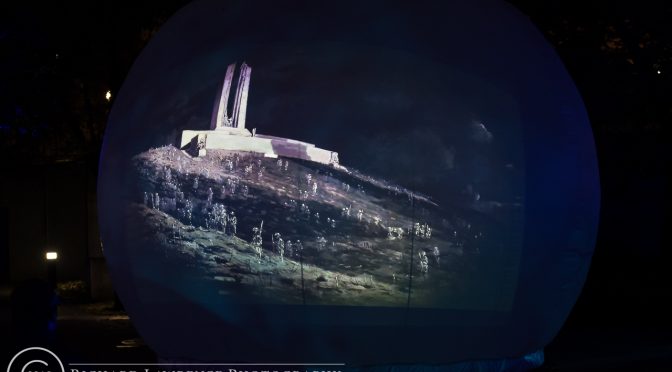Traditionally, remembrance ceremonies are traditional, predictable, and pretty much the same regardless of the group or organization putting it on. This holds true from the small town ceremonies at the local cenotaph to the National Remembrance Ceremony held at the National War Museum in Ottawa. This is why I was quite pleased to find two remembrances that have marched into the 21st century with the full use of multi-media: one from the Royal Canadian Legion and the other from Veterans Affairs Canada.
It is not a well-known fact that the Royal Canadian Legion (Legion) is the organization behind the National Remembrance Ceremony in Ottawa and not the government of Canada. It is steeped in tradition and reverence for those who sacrificed themselves for their country and it needs to be the pomp and ceremony that it is. But this year, the Legion has added a new twist with a multi-media production hosted on the National Art Centre’s (NAC) Kipnes Lantern.
What is the Kipnes Lantern? It’s the new all glass entranceway to the NAC that is listed as three stories tall but considering that each of those stories appears to almost double height, it actually towers about five stories into the night sky. On four sides of this tower transparent LED panels have been installed which are practically invisible when it’s not in use. When it is in use, it transforms the tower into a multi-sided, high-definition video wall and this is what the Legion has taken advantage of.
Starting at 7 am on 11th November, the Kipness tower will light up and show images from WWI and then the famous “Poppy Drop” which is a cascade of poppies falling from sky to street. Now, I’m sure this will be interesting during the day but I’d suggest going after sunset to really get a sense of what it is. The Lantern is bright and colourful and showcases in a spectacular manner the images of soldiers and people left back home, surely visible for miles (albeit blocked by buildings downtown). And there is some serenity in just watching the Poppy Drop portion of the production which will allow you to reflect on the day.
Not far away, in Confederation Park, Veterans Affairs has set up the “Moon Garden” which is a series of inflatable spheres showing a 14 minute multi-media production titled “the Edge of Peace”. On the various spheres four WWI soldiers reflect on their service during the last 100 days of the war and a recently bereaved singer tries to find meaning and consolation by performing a new song. There are also images from WWI projected onto the spheres and other bits of artwork.
As well, there is one sphere, the SpeakTree sphere, dedicated to showing messages from Canadians texted to a phone number and then redirected to this sphere in near-real time (all messages are vetted first). The way this works is that a person texts a message to 438-800-0471 and then it appears on the sphere as branches on an ever growing 3D tree.
It’s good to see these organizations starting to think in the vernacular of youth and attempt to get the message out about Remembrance in a more modern manner, really attempting to engage a younger audience that historically are less interested in traditional remembrance ceremonies. The Poppy Drop production from the Royal Canadian Legion starts at 7:00 am on the 11th November and will continue on a loop until midnight at the Kipnes Lantern entrance to the National Arts Centre on Elgin Street. The Edge of Peace will continue to run daily in Confederation Park until the 11th November from about 4:30 pm to 10:30 pm. They’re close together and neither runs very long so take them both in.
To see all the images, CLICK HERE
=================================================

























